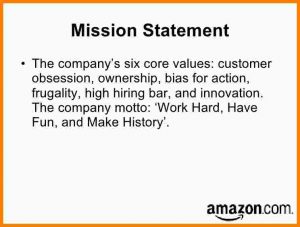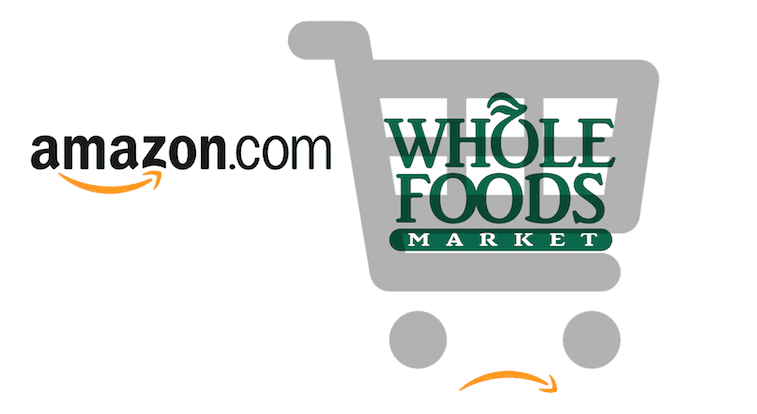The $13.7B purchase of Whole Foods by Amazon this summer will be a bell-weather for Amazon's future. Share on X Will Amazon transform Whole Foods or vice versa? As this WSJ article posits, so far the impact seems to be the former. Naturally, the whole reason Whole Foods had to be acquired was because they were lacking in the results department. It will indeed be interesting to see how (and why) Whole Foods will adjust its missionary position. Presently, the Whole Foods mission statement includes such phrases as “We are a mission-driven company that aims to set the standards of excellence for food retailers” and “Quality is a state of mind.” Moreover, Whole Foods intimates that their 8 values are immutable:
“These are not values that change from time to time, situation to situation or person to person, but rather they are the underpinning of our company culture.”
But will they change from owner to owner?
A clash of values?
The Whole Foods Declaration of Interdependence (that was originally penned in 1985 and updated three times, the last time being in 1997) includes some bold statements that would seem potentially in conflict with the de facto life at Amazon. There are two absolutely vital points of difference between Amazon and Whole Foods. (1) Whole Foods have identified a higher purpose and (2) they consider employee happiness their third highest value: “WE SUPPORT TEAM MEMBER HAPPINESS AND EXCELLENCE.” They even talk about self-responsibility, to which Caleb and I profoundly subscribe in our new book, Futureproof.
Whole Foods is positioned as a premium retailer and, as such, somewhat naturally includes the ‘luxury’ desire to adopt a win-win mindset with its broader stakeholders: “We view our trade partners as allies in serving our stakeholders. We treat them with respect, fairness and integrity and expect the same in return.” But, is that a viable position as a retailer? Already, Amazon has mandated the elimination of brand representatives in Whole Foods’ stores who previously were encouraged to come in to promote their products or check how their brand is presented on the shelves. I think we’re likely to see more of these moves.
Inserting Real Values in Retail?

Reality is that the distribution business is a cut-throat environment. Retailing is a tough if not mean business. It basically always has been. I can recall the almost war-like nature of relationships and negotiations between L’Oreal and the big name retailers. As reported in the New York Times, the work culture at Amazon is tough as nails. Amazon’s leadership principles speak to a hard-nosed, cut throat environment. For the Whole Foods employees, there is potential for toxic shock when they come into contact with the full force of the Amazon culture. The same was probably true at Zappos when it was acquired by Amazon, albeit less so because Zappos was in the same fundamental business of eCommerce and had a shared 100% obsession around customer satisfaction. With retailers, though, the challenge is finding the margin to allow for anything other than driving hard bargains, cheapest logistics and skimpiest wages. Share on X
The Retailer’s Stakeholders
There is no doubt that the one stakeholder that retailers live and die by is the customer. As an Amazon customer, I’m deeply thankful for their marvelous service. In this capital intensive business, shareholders represent a non-negligible force, too. As shareholders, they are right to be attentive to Amazon’s strategic drive and cost consciousness. However, retailers require healthy brands as well; and that is a trickier space as there is an inevitable struggle for power (and ownership of the customer) between retailer and brand. As an author (aka supplier), I have to thank Amazon for its well-oiled global marketplace. Yet, I certainly don’t feel like an ally; but rather as a tiny cog in their vast machine. Of course, I’m just a two-bit author, so I am not relevant in the big picture. Nonetheless, for having seen how Amazon operates with big name publishers, I do wonder about its relationship with brands and suppliers.
The Amazon Mission….

The Amazon mission, on the face of it, is powerful and relevant. “Our vision is to be earth’s most customer centric company; to build a place where people can come to find and discover anything they might want to buy online.” However, as I have argued in the past, it is missing out on bringing along all the necessary partners, including importantly its key stakeholders, the employees. I maintain that a brand is something that is lived, not communicated. In today’s transparent and highly connected world, the employee is responsible for bringing the brand to life. Even a retailer should think of itself as a brand. Yet, if the internal slogan of Amazon is defined as: “Work Hard. Have Fun. Make History,” I have yet to find many employees enjoying the meat sandwiched in between Work Hard and Make History. On the Have Fun count, they don’t register. I like to make the parallel with Uber that has systematically failed to treat its drivers with sufficient care. Whether it’s behind a screen or the car wheel, the employees are crafting and embodying the living brand. Without them, the service crumbles.
Being customer centric is not enough
Of the commonalities between Amazon and Whole Foods — which surely dominated the acquisition discussions — both companies do share a stated obsession with the customer. As discussed with Stan Phelps in our recent podcast, being customer centric is a venerable intention and, presumably, sine qua non for a retailer. But, in my opinion, as I have declared before, Amazon must find ways to make its value system more meaningful. As Stan would say, they need to move from a Business 2.0 (customer focus) to a Business 3.0 status (employee centric) if not Business 4.0 (purpose). [For the record, Business 1.0 = focus on shareholder].
With their missionary position, Whole Foods, on the face of it, encompasses all the key tenets in our new book, Futureproof: Meaningfulness, Responsibility and Collaboration. However, exasperatingly, they failed because of [insufficient] performance. This begs the question whether a company can survive with an ethos of conscious capitalism? And it remains to be seen whether some of Whole Foods’ values will wash off on Amazon, or will be washed away by the weight of Amazon’s culture and the quest for profits. It’s hard to imagine how a premium brand can survive long-term with a hard-nosed, cost-cutting philosophy.
Your thoughts and reactions please?











